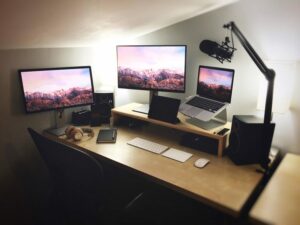Sitting at the kitchen table hunched over a laptop screen is not ideal, but it is the situation many are in after the shift to remote work. Based on our experience, the four hardware investments below will increase your productivity and comfort while working remotely.
Laptop with decent camera and microphone
Most laptops produced in the past two years have good-quality cameras and microphones. If your laptop supports Windows Hello (and it should), you know you have a quality camera setup. All Microsoft Surface, Apple, and most business-class Lenovo and Dell laptops will have quality cameras. You are going for at least 1080p or better. If you work from a desktop or older laptop, invest in a quality webcam to clip onto one of your monitors. Position the webcam so you are focused, and the proper lighting is in the background. You may need external lighting to help, but start adjusting your camera angle first.
Sound is still the most important part of communication and is often overlooked. To test your microphone, open up the Camera app, switch to video, and then record a clip of you talking as you normally would on a video call. Is the audio and picture clear? We often “talk” to a screen and not towards the actual mic. Most laptops have the mics set up right by the camera, so talk directly to the camera if you can. If that’s impossible, invest in a USB microphone you can position correctly. All the YouTubers and podcasters have one, maybe you should too!
At least two external monitors and a laptop screen
Nothing helps working remote productivity more than external monitors. A dual-monitor setup makes a user 300% more productive than working with a single screen (nobody wants to deal with having to open and close applications constantly!) Better yet, throw in an additional laptop screen; now you have a screen to dedicate to your music app! Even portable external monitors can connect to your laptop on the go.
If possible, avoid mix-n-match for your external monitors. The brightness, color, and resolution should match between them to reduce eye strain.
Wireless mouse and keyboard when working remote
A wireless mouse and keyboard will keep your workspace free of wires and give you the ability to move around and reposition if needed when working remote. For an external keyboard, you’ll want to find an ergonomic one that allows your hand and wrist to function properly. Some of the portable smaller ones are harder to use on a daily basis.
Monitor stands – neck strain is real
Lastly, a monitor stand is necessary for minimizing neck strain when working remote. Avoid this by getting a decent monitor stand that can be elevated to suit your eye level. This will prevent you from looking down at your computer and staring at the screen all day. Plus, this will save a ton of space on your desk. To further improve this setup, make sure your desktop monitors are positioned so that you can be seated further away without having to squint your eyes.
By implementing a few or all of these setups, you’ll have the ideal remote office setup to ensure you can be comfortable and productive.

